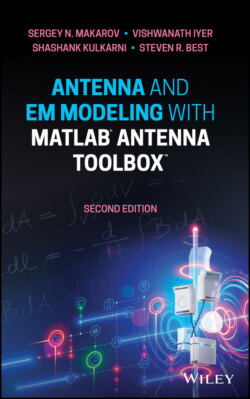Читать книгу Antenna and EM Modeling with MATLAB Antenna Toolbox - Sergey N. Makarov - Страница 19
Example 1.3
ОглавлениеA transmitting antenna in a radio handset features a monopole antenna. It is connected to a sine wave generator that has the same basic form as Figure 1.1 with an internal (generator) resistance of 50 Ω. The antenna has the radiation resistance of 50 Ω (which generates power loss in terms of electromagnetic radiation); its loss resistance is zero. The antenna, when properly matched to the power source, will radiate 50% of the total power. Now, a young RF engineer decides to “modify” the handset by cutting the monopole antenna and leaving only one‐third of its length, so that the antenna's radiation resistance is reduced to one‐ninth of its original value. How does this affect the radiated signal?
Solution: For a periodic AC signal the average antenna power is given by Eq. (1.5d), that is
(1.8)
The ratio of the two power levels for the two antenna configurations does not depend on generator voltage, i.e.
(1.9)
Thus, for the shorter antenna we will only achieve about 36% of radiated power compared to the original handset. In practice, this estimate becomes even much worse due to the appearance of a very significant antenna reactance as explained in the following text.
